When it comes to managing your feline friend’s litter needs, have you ever thought about how much cat litter would fit in a storage container?
Whether you’re a single-cat household or the proud owner of a clowder, knowing the amount of litter that can be stored is vital for maintaining a clean and odor-free environment. (1)
So, how much cat litter will fit in a storage container?
Proper storage does more than just keep your space tidy—it also ensures that the litter retains its absorbing properties, providing your pet with a fresh spot every time.
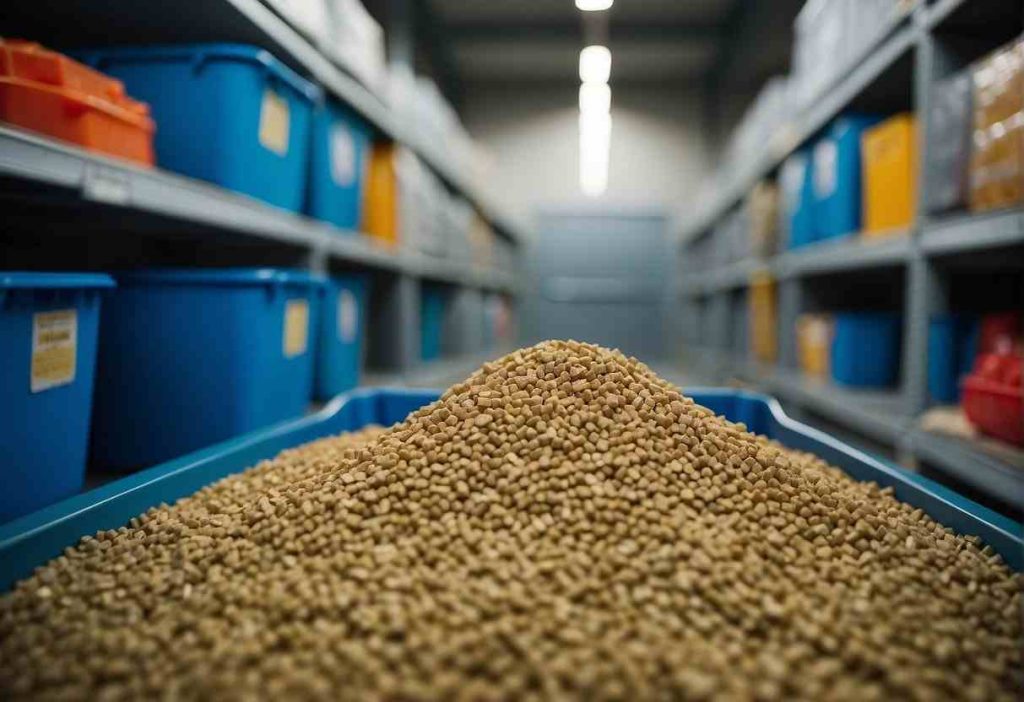
Before eyeing that empty bin in your garage, consider the size of your cat, the number of cats you have, and the type of litter you use. (2)
These factors dramatically affect how much litter you should have on hand and the size of the container required.
For instance, clumping litter may require less frequent changes, but it generally means you’ll store more at once. (3)
Conversely, non-clumping varieties might see more turnover and thus, different storage considerations.
Calculating the right capacity for your needs prevents the hassle of constant refills while keeping your cat’s bathroom fresh and inviting.
Now, grabbing a matching lid might not be as exciting as watching your cat chase a laser pointer, but it’s crucial for maximizing your litter’s shelf life.
A container with a tight seal wards off humidity and pests, keeping the contents dry and usable for longer periods.
It’s about striking the perfect balance between sufficient quantity and ensuring the quality doesn’t dip.
Designate a convenient spot for stashing the litter, and you’ll not only streamline your cat care routine but also eliminate unsightly bags from cluttering your home.
And hey, you might even impress your furry friend with your superior organizational skills!
Key Takeaways
- Storing cat litter properly helps maintain its effectiveness and controls odors.
- Tailoring storage needs based on the number of cats and type of litter optimizes quantity.
- A good seal on the storage container prolongs litter freshness and simplifies care.
How Much Cat Litter Will Fit in A Storage Container? Selecting the Ideal Storage Container
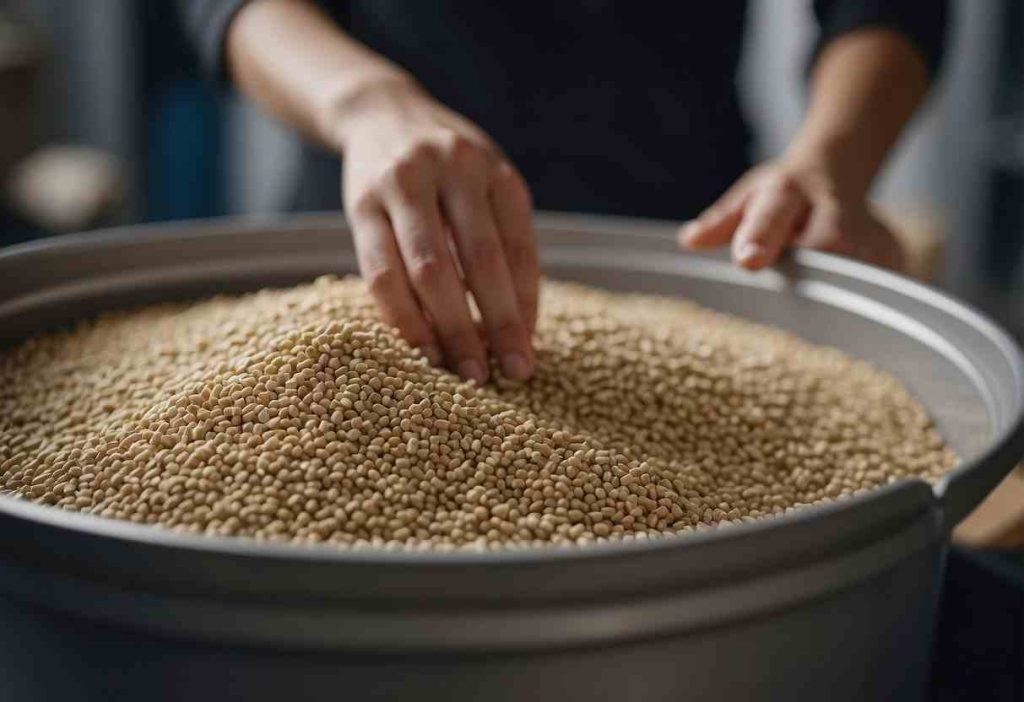
Types of Storage Containers
Who knew there were so many homes for kitty’s necessities?
First off, there’s the classic plastic bin. Durable and easy to clean, but watch out—scratches can harbor odors.
Moving on, metal containers provide a sleek look with superior odor control. However, they could be a tad heavy. (4)
Then there are the fabric sacks, lightweight and flexible, but they might just give in to wear and tear too soon.
| Material | Durability | Odor Control | Ease of Use |
|---|---|---|---|
| Plastic | High | Medium | High |
| Metal | Very High | High | Medium |
| Fabric | Low | Low | Very High |
Factors to Consider
Decisions, decisions! Size does matter—make sure your container can fit all that litter. Shape-wise, consider where you’re placing it; a square or rectangular bin is space-efficient.
How about that seal? A good one will keep those unwanted smells at bay. Also, a container with easy access will make your life a breeze when it’s time to scoop or refill.
And hey, let’s not forget looks—your container should complement your home too!
- Size: Match the amount of litter
- Shape: Fit the space
- Seal Quality: Keep smells in
- Ease of Access: Quick scoop and refill
- Aesthetics: Shouldn’t be an eyesore
Choosing your cat litter container is like picking a new friend for your home. Make it count!
Calculating The Storage Capacity
Understanding Container Volume
First off, grab your tape measure. To work out your container’s capacity, you’ll need to know its dimensions. For a rectangular prism (that’s your typical boxy shape), the formula is length × width × height. Easy, right?
And for those of you with a cylindrical container, the formula is π × radius² × height. Just measure straight across for the diameter, halve it for the radius, and multiply away.
Cat Litter Density and Volume Conversion
- Clumping Clay: typically denser, with a density around 0.8-0.9 g/cm³ (5)
- Silica Gel: lighter, with a density near 0.5 g/cm³ (6)
- Recycled Paper: the featherweight champion, a density of around 0.3 g/cm³
To convert weight to volume, use the density (weight per volume) and do a bit of division. Did you get 10 pounds of clumping clay litter? That’s around 5,500 cubic centimeters.
Example Calculations
Let’s say your container is 12 inches (30.48 cm) long, 16 inches (40.64 cm) wide, and 10 inches (25.4 cm) high. That’s a rectangular friend, so multiply those numbers. You’ve got 31,104 cm³ to fill with litter-joy.
Filling it with clumping clay? Divide your container’s volume by the density:
31,104 cm³ ÷ 0.9 g/cm³ ≈ 34,560 grams or 34.56 kg
That’s your clumping clay limit! A cylindrical container, though, with a radius of 8 inches (20.32 cm) and height of 10 inches (25.4 cm)?
Your volume is π × 20.32 cm² × 25.4 cm ≈ 41,000 cm³
Follow the same steps for each litter type, and you’re all set. No surprises when buying litter again!
Remember, taking a moment to measure and calculate can save your day from a catastrophic mess! Keep it neat, tidy, and purr-fectly stocked.
Maximizing Storage Efficiency and Freshness
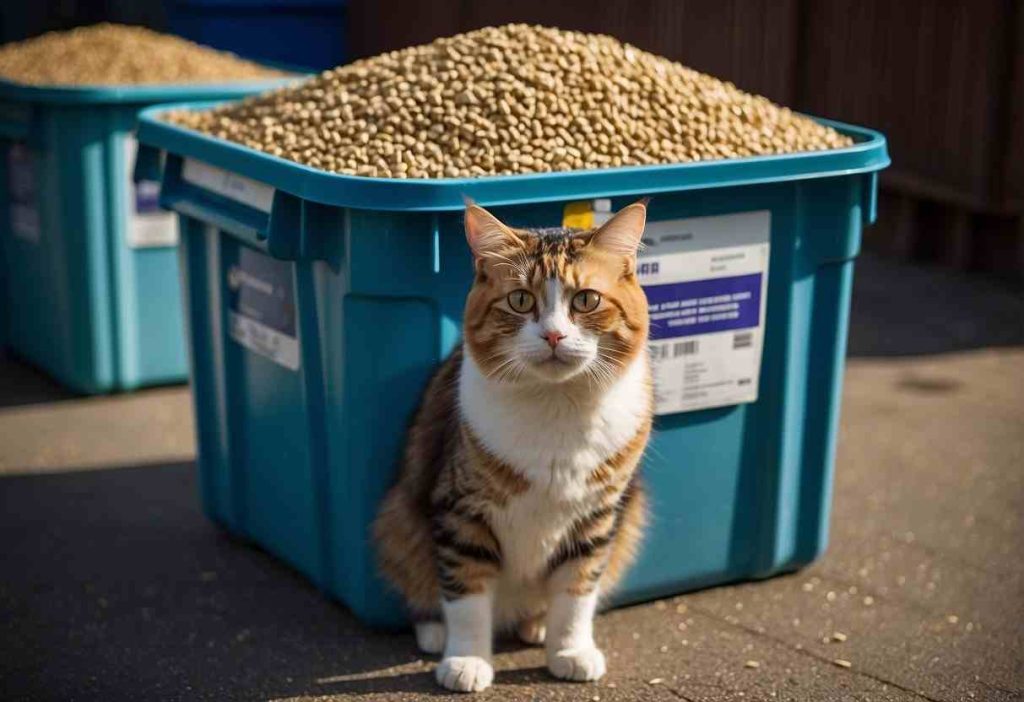
Creative Storage Solutions
- Stackable Bins: Have limited space? Consider stackable containers, they’re a real game-changer. By stacking bins, you use vertical space, saving precious floor space. Plus, they make it super easy to organize different types of litter.
- Compartments: If you use multiple litter types (clumping, silica gel, etc.), separate compartments within a single bin can be a lifesaver. This method keeps everything tidy and within arm’s reach!
Tips for Preserving Cat Litter Quality
- Keep It Dry: Moisture is the enemy of cat litter. To combat this, toss a few desiccant packets into your storage bin. They absorb excess moisture and keep your litter dry. (7)
- Rotate Regularly: Just like in a store, rotate your stock. Use the “first in, first out” rule to ensure older litter gets used before newly purchased bags.
Handy Table for Keeping Track:
| Date Added | Type of Litter | Use By |
|---|---|---|
| Mar 25 | Clumping | May 25 |
| Mar 30 | Silica Gel | May 30 |
Do you already use some of these strategies? Or maybe you’ve just discovered the secret to cat litter longevity.
Either way, you’re on the path to a happier nose and a happier cat.
Just remember, your cat’s comfort is as important as storage convenience—so, here’s to finding that purr-fect balance!
Practical Tips for Cat Litter Storage
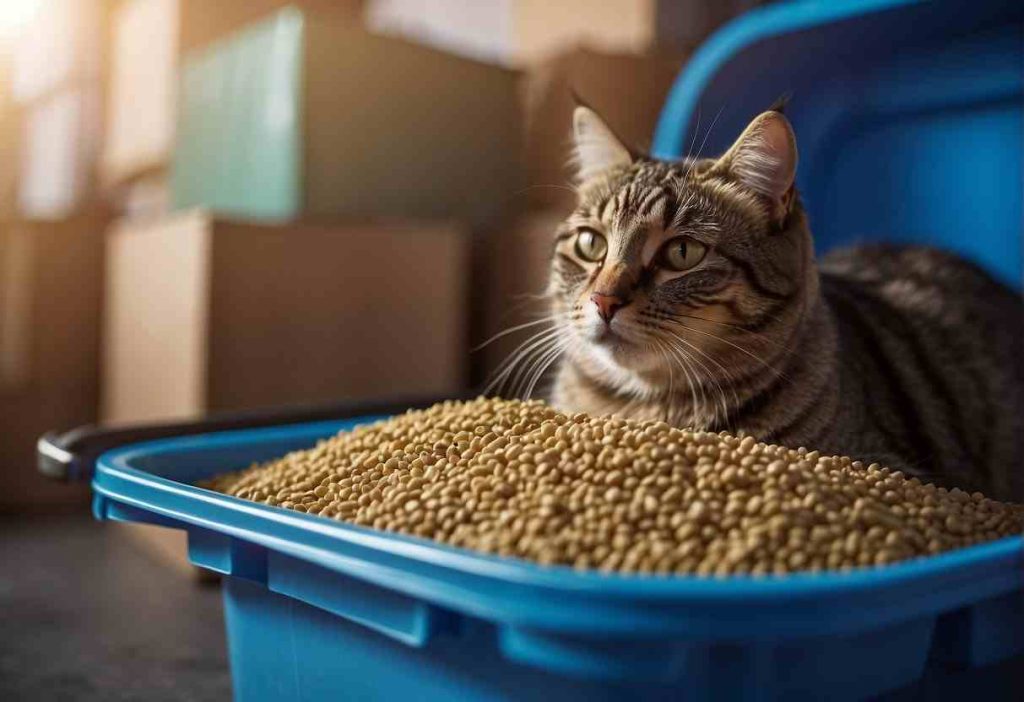
1. Safe Spot, Happy Cat:
First things first, let’s keep it safe.
Remember that the perfect spot is out of reach from your curious pets and kids, but still within arm’s reach for you. You don’t want Fluffy turning your storage spot into a playground, right?
2. Handy and Tidy:
Keep things within easy reach but orderly. You could use a scoop with a hanging clip to store it on the side of the container.
3. Freshness First:
Ever bought litter in bulk and noticed an expiration date? That’s right, some cat litters have them! Keep an eye on those dates. Nobody likes stale litter, especially not your feline friend.
4. Divide and Conquer:
Did you buy too much? It can be hefty lifting a giant bag of litter. Try using multiple smaller containers. It’s way easier on your back, and you can rotate which one you use to keep the litter fresh.
5. Label Love:
Do those smaller containers? Great! Now slap a label on them.
Trust me, knowing which is which at a glance is a game-changer.
6. Sealed and Delivered:
Make sure your containers are sealed tightly. A good seal keeps the litter dry and odor-free.
Looking to spruce up your cat’s bathroom routine? Keep these tips in mind next time you’re staring down that colossal bag of litter at the store.
With these strategies, both you and your cat can enjoy a clean, fresh, and organized space.
Real-world Applications and Case Studies

Success Stories:
Meet Emily, who used to struggle with messy litter bags until she found the perfect 50-liter storage bin.
With a snap-tight lid, her litter is fresh and her living room is clutter-free! Check out her setup:
- Storage Bin Size: 50 liters
- Cat Litter Stored: 20 kg
- Duration: Lasts her cat two months
Love DIY projects? Let’s get crafty with everyday items:
DIY Storage Container Projects:
- Upcycling an Old Bin:
- Materials: Old trash bin, plastic liner, scoop holder
- Steps:
- Clean the bin
- Secure plastic liner inside
- Attach a scoop holder on the side
- Result: A cost-effective, custom litter storage!
- Reusing Large Buckets:
- Materials: 5-gallon bucket, lid, labeling materials
- Steps:
- Wash and dry the bucket
- Pop on a tight-fitting lid
- Label it with some flair
- Result: No more spills and a personalized touch to your cat corner!
Fascinated by these transformations? Yours could be next!
Just remember, while you’re getting your hands dirty, your furry friend can look forward to clean paws and a pristine play area.
Quick Recap
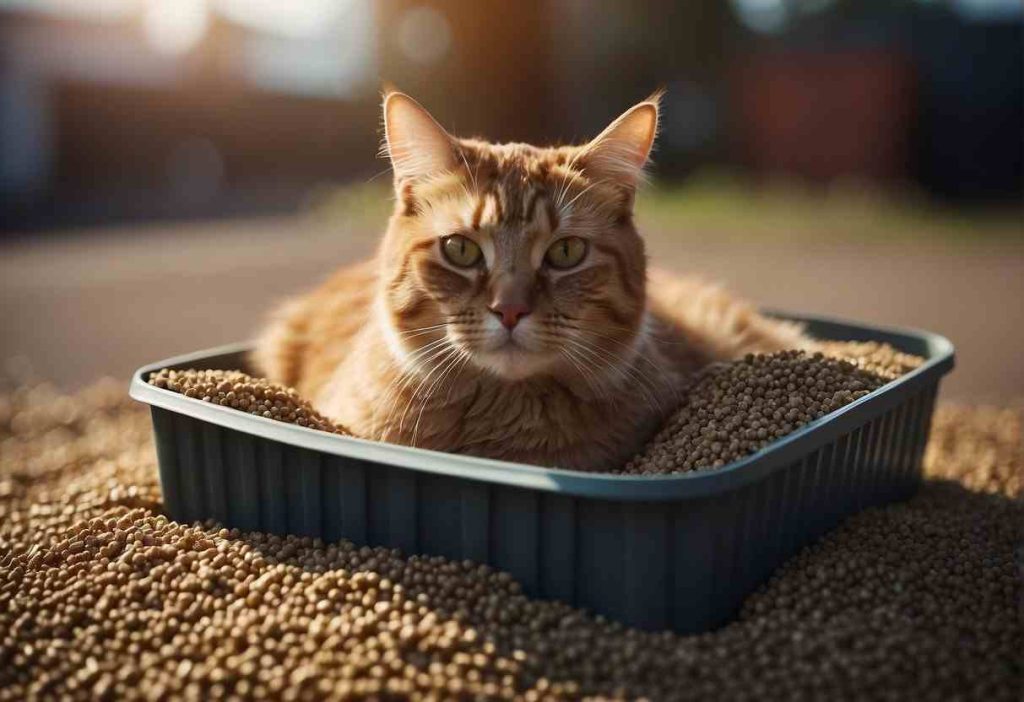
It’s not a simple guesswork game; it requires a bit of calculation and some practical consideration:
- Container Size: The size of your container determines how much kitty litter it can hold. Make sure you choose the right one!
- Calculating Capacity: Remember the formulas we discussed? To calculate the volume for rectangular containers, it’s length x width x height. For cylinders, it’s π x radius² x height. Make sure your measurements are in the same units!
- Litter Amount: Standard bags of cat litter usually range from 5 to 40 pounds. Be sure to check the bag’s volume to make an informed decision.
- Freshness: You want to keep the litter fresh for your feline friend, right? A tight-fitting lid is essential to prevent moisture and odors from sneaking in.
- Organizing Tips: Stackable containers save space, and clear ones let you see when you’re running low.
Here’s a simple table for quick reference:
| Bag Weight (Pounds) | Approx Volume (Cubic Feet) | Container Size (Cubic Feet) |
|---|---|---|
| 5 | 0.2 | To match your needs |
| 20 | 0.8 | |
| 40 | 1.6 |
Remember these tips, and you’ll never get caught out by a storage snafu or a litter shortage again.
Keep these pointers in mind, and you’re all set for a hassle-free cat care experience!
Frequently Asked Questions
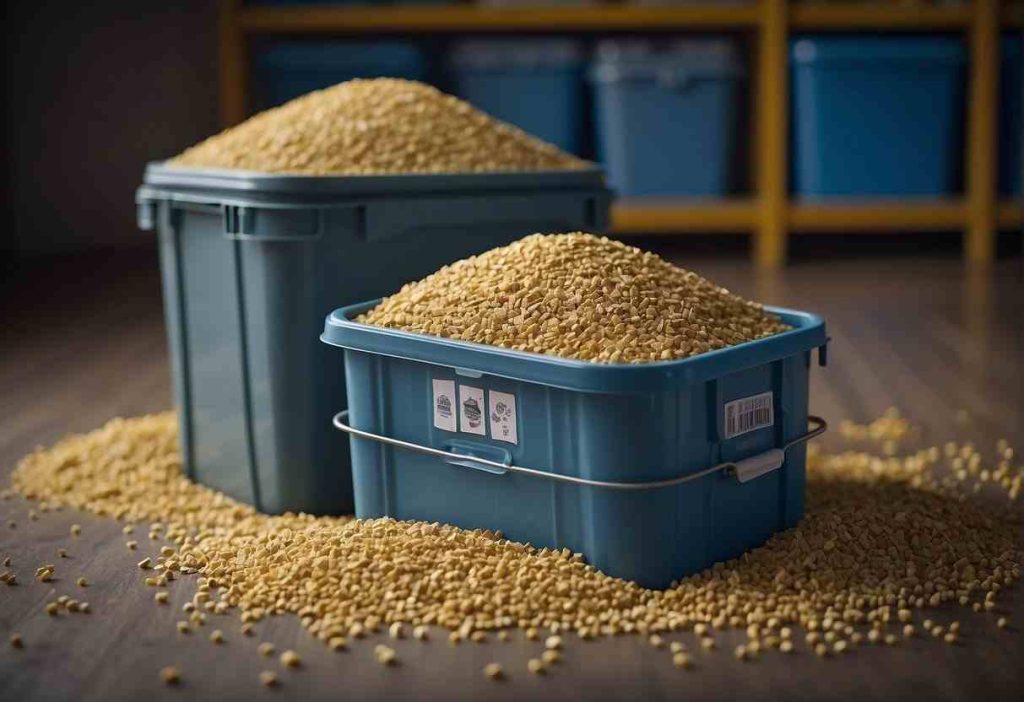
How do I calculate the volume of my storage container for cat litter?
To calculate the volume of your storage container, you just need to do a simple math equation.
If it’s rectangular, multiply the length by the width by the height (L x W x H). That gives you the volume in cubic inches, feet, or meters, depending on your measurements.
For a cylindrical container, the volume is π times the radius squared times the height (πr²h). Don’t forget, there are plenty of online calculators to do the work for you!
What’s the ideal container size for storing 40 lbs of cat litter?
A 40 lb bag of cat litter typically needs about 2 cubic feet of space.
But bear in mind, that you’ll want a tad more room to avoid spills when scooping.
So, look for a container that’s at least 2.2 to 2.5 cubic feet to keep those 40 lbs comfy and your space clean.
What is the best way to measure cat litter when filling my container?
The scoop-and-level method works wonders!
Use a cup or scoop, fill it with litter, and level it off for a consistent measure every time.
And if you’re transferring directly from a bag? Pour slowly and statefully to avoid the dreaded overflow.
Can I store different types of cat litter together?
It’s best to keep them separate. Different litters can have varying absorption and odor control properties, and mixing them might compromise their effectiveness.
So, play it safe—give each type its own special spot.
How can you keep a cat litter storage container clean and odor-free?
Wipe down your container regularly with a mild detergent or vinegar solution to banish grime and germs.
And don’t forget to fully dry it before refilling to prevent clumping. For that extra freshness, consider a sprinkle of baking soda on the bottom before adding new litter.
What is the best way to store unused cat litter to keep it fresh?
Keep it in a cool, dry place away from moisture to prevent clumping or spoilage.
An airtight container will do the trick nicely—it keeps the litter fresh and fends off any funky odors.
What are some clever cat litter storage solutions that save space?
Opt for stackable containers that can slide into narrow spaces or fit snugly in a closet.
Hanging dispensers can also be a clever trick—talk about a gravity-fed system for easy pouring!
Remember, creativity is king when you’re aiming to maximize your space.
- The Ultimate Overview to Actual Cash Gambling Establishments - July 1, 2025


